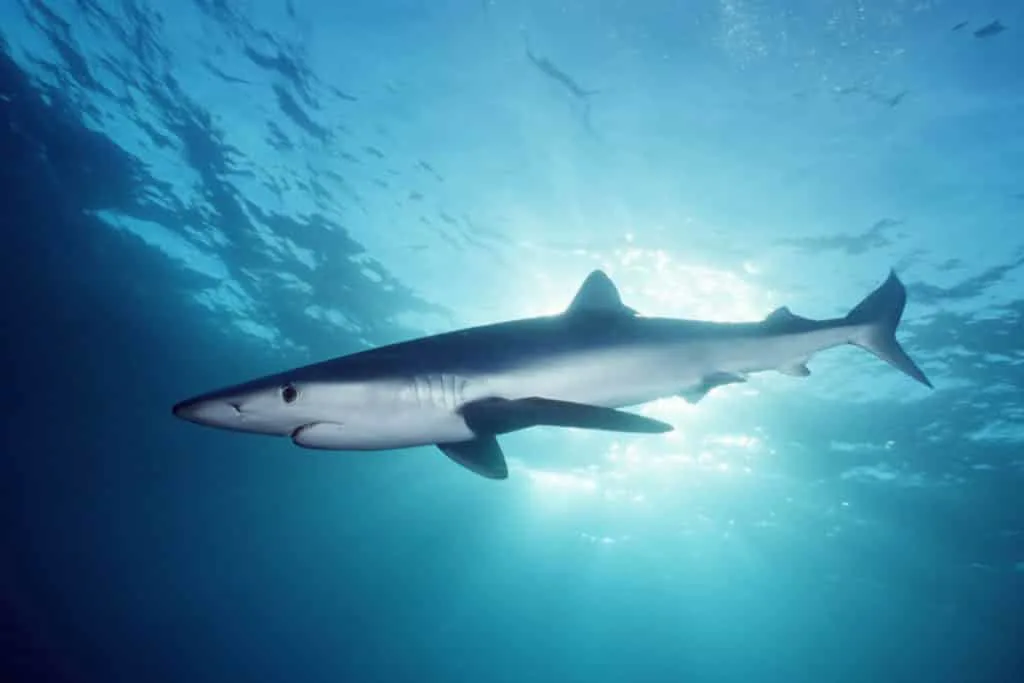Have you ever wondered what it is like to dive with one of the most curious yet gentle sharks in the world? A mesmerizing adventure awaits. We collected where to dive with Blue Sharks.
Find all the research to help you discover Blue Sharks in their natural habitat below.
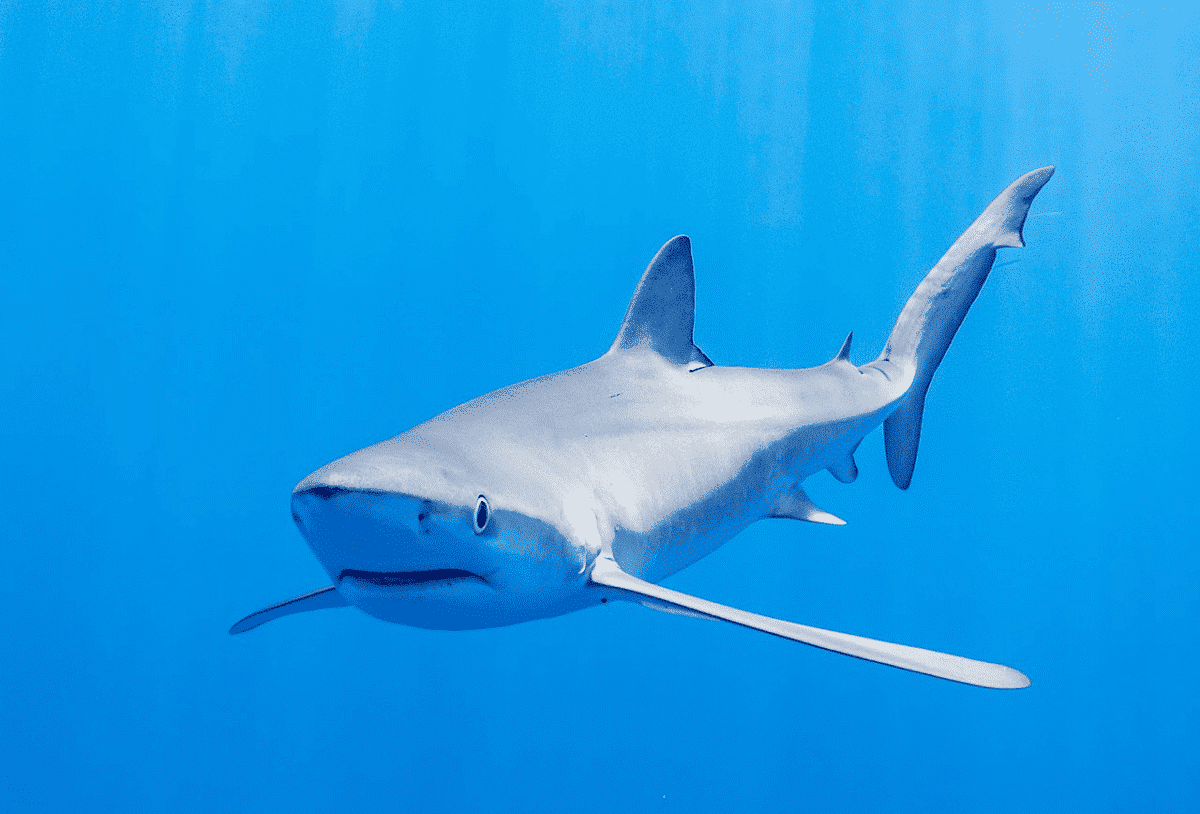
This article teaches you about Blue Sharks and where you can dive with them. You can read the whole article from the beginning or jump straight to the most relevant chapter for you:
Key Points
| Key Points | Description |
|---|---|
| Get to Know Blue Sharks | – Blue sharks are loved by both divers and photographers for their beauty and speed. – In recorded history, only four fatal accidents involving blue sharks have occurred. – They are remarkable swimmers. |
| Endangerment of Blue Sharks | – Blue Sharks are in global decline due to human activities, primarily driven by the demand for shark fins. – They are marked as “near threatened” by the Red List of the International Union for the Conservation of Nature. |
| Geographical Distribution of Blue Sharks | – Blue Sharks inhabit tropical to temperate seas worldwide, with specific regions including the North Atlantic, Mediterranean Sea, North Sea, and Northwest Atlantic. |
| Diet of Blue Sharks | – Blue Sharks have a diverse diet, consuming various fish species, smaller sharks, and unfortunately, indigestible garbage often found in their stomachs. |
| Best Places to Dive with Blue Sharks | – Promising dive locations include the Azores (Portugal) and Cape Town. |
Get to Know Blue Sharks
Blue Sharks are a favorite for divers and underwater photographers due to their beauty and speed. Another characteristic that makes it so special to dive with them is their curious yet gentle behavior.
In the recorded history of shark bites, which started in 1580, only four fatal accidents – less than once every 100 years – are attributed to Blue Sharks. They are also incredible swimmers, traveling over 4000 miles within 3 months.
Before we dive into where to find the most promising places to dive with Blue Sharks, lets give you some background information about these wonderful sea creatures.
Endangerment of Blue Sharks
Blue Sharks are decreasing in numbers worldwide, as 10 to 20 million sharks are killed per year by humans. This makes the Blue Shark the most heavily caught fish on earth.
Primarily, the shark’s fins are sought after by shark-fin soup enthusiasts. Decreasing the demand for this soup could contribute significantly to conserving this beautiful and gentle shark species. Aside from the fins, Blue Sharks are not particularly tasty. Hence, the rest of their bodies are mostly used for fish meal production.
Today, on the Red List of the International Union for the Conservation of Nature, the Blue Shark’s level of endangerment is marked as near threatened.
Blue Sharks are incredibly gentle creatures towards humans. Let’s focus on just observing instead of overfishing them.
Geographical Distribution of Blue Sharks
The Blue Shark usually lives off the coast shelf and dives to a depth of approximately 350 meters. It resides in all tropical to temperate sea areas and is probably the most widespread species of all sharks.
Very often, Blue Sharks are sighted in the North Atlantic to the South Coast of Great Britain to Senegal as well as around the Azores, the Canary Islands, Cape Verde, and Madeira. Blue sharks also populate the Mediterranean Sea and are summer visitors to the North Sea, the Skagerrak, and waters off Norway. In the Northwest Atlantic, it is mainly found far off the coast of Florida and the Antilles, where it is a summer guest in the Gulf of Maine, off Newfoundland and Nova Scotia.
In the South Atlantic, the shark regularly occurs as a deep-sea species off South Africa and off the South American coast (Argentina, Brazil, Uruguay). Also, in the Indian Ocean, Blue Sharks are occasionally found between the 35th and 13th southern latitude; near the coast (for the ones of you who are into geography ;P). In the Pacific Ocean, it can be found in all warm temperate areas.
Diet of Blue Sharks
The Blue Shark, as a large deep-sea shark, eats almost everything it finds. The main part of its food consists of fish of any size, mainly schools of fish such as herrings, mackerels, sardines, or tunas. In addition, it hunts smaller shark types.
The fishery remains thrown into the sea to supplement their diet. Unfortunately, indigestible garbage can also be found regularly in its stomach.
Best Places to Dive with Blue Sharks
Blue Sharks are at home in the open ocean. Hence, diving with them often involves being “out there”. It means waiting in the endless blue, but as wise men say, patience and endurance are the keys to the highest rewards.
As most Blue Shark dives are conducted in blue waters without any orientation during the dive, they should not be taken lightly. Generally, it is recommended to have great buoyancy control. Also, divers must always pay attention to their depth and orientation.
Do you like diving with sharks? Have a look at our recent article about Great White Shark Diving.
Often, on a Blue Shark dive one experiences the following: Divers hang in the water between 20 and 30 meters. Testing their patience before, if you are lucky, dark shadows arise in the distance coming closer and closer. Suddenly, the silhouettes of the Blue Sharks turn into detailed pictures right in front of your eyes and these wonderful animals are within reach, but before you know it they have turned around.
We show you the places on this planet where you are circled by these magnificent and elegant creatures rather sooner than later. Ensuring your patience is not tested for too long…
Criteria to Rank the Best Places to Dive with Blue Sharks
The following ranking is sorted after criteria which according to us, is the most relevant for divers, namely:
- How Likely is it to encounter Blue Sharks.
What the situation with diving schools at the respective Blue Shark diving spot is like.
Check out our other shark tale.
- The water visibility.
1. The Azores, Portugal
One of the most promising spots for encounters with Blue Sharks can be found within Europe’s “best-kept secret”: The Azores. An island group that belongs to Portugal and lies between America and Europe in the Atlantic Ocean. Already well-known to sailors as a pleasant stop on a cross-Atlantic turn, now gaining more attraction with adventure tourists and divers. The green islands feature volcanos, dramatic waterfalls, and chill vibes in restaurants and bars.
Besides diving with Blue Sharks, the Azores are also popular for diving with Mako Sharks, Mobula Rays, Dolphins, Hammerhead Sharks, Black Marlins, and even Whales. All of these animals can be found just off the most renowned diving site on the Azores, the Princess Alice Bank.
Key statistics to diving with blue sharks on the Azores:
| Best Time | Beginning of July to mid-October |
| Water Temperature | 21 – 25°C / 70 – 77°F |
| Visibility | Usually 30+ metres |
| Chance to encounterblue sharks | Higher than 90% |
| Qualification | Advanced Open Water Diver or equivalent |
Best Diving Schools on the Azores for Blue Shark Diving
Multiple diving schools are offering Blue Shark dives. Here are the most reliable ones (Rated on Google Maps and Trip Advisor):
- Norberto Diver, Faial Island
- Cetacean Watching, Pico Island
- Dive Azores, Faial Island
- Twin Peaks Diving Centre, Pico Island
- Brizaçores, Pico Island
2. Cape Town, South Africa
Cape Town has plenty to offer: hiking Table Mountain, exploring the local bar and club scene, visiting wineries, or cage diving with great white sharks.
Yet, you could make your trip to Cape Town even more remarkable by experiencing a dive with Blue Sharks in the open water without a cage.
Key statistics to diving with blue sharks in Cape Town:
| Best Season | November – June |
| Water Temperature | 16 – 25°C / 60 – 77 °F |
| Visibility | 10m – 50m |
| Chance to encounterblue sharks | Higher than 80% |
| Qualification | Open Water or above but snorkelling is possible |
Best Diving Schools in Cape Town for Blue Shark Diving:
- Pisces Divers, Simon’s Town, Cape Town
- Into the Blue Scuba Dive Centre. Cape Town
- Shark Explorers, Simon’s Town, Cape Town
- Ollava Scuba, Cape Town
3. Cabo San Lucas, Mexico
Cabo San Lucas, a paradise for relaxation, nightlife, and sunbathing, can also show a different side. If you are looking for a thrill-filled adventure connected to nature, you ought to take a look at diving with blue sharks during your holidays.
Cabo San Lucas is one of the world’s top destinations for shark diving. Just off the shore, the arguably highest concentrations of blue and mako sharks can be found. Diving schools offer dive trips seven days a week all year round. Besides Blue Sharks, Mako, Hammerhead, and Silky Sharks are frequent visitors during dives.
Blue Sharks can be spotted during all months. However, their prime time around Cabo is between January and May.
Key statistics for diving with blue sharks in Cabo San Lucas, Mexico:
| Best Season | January – May |
| Water Temperature | 23 °C / 73 °F |
| Chance to encounter blue sharks | Near 100% |
| Visibility | 30 meters – 50 meters |
| Qualification | Open Water or above but snorkelling ispossible |
Best Diving Schools in Cabo San Lucas for Blue Shark Diving:
A few diving schools are offering Blue Shark dives. Here are the most reliable ones (Rated on Google Maps and Trip Advisor):
4. Rhode Island, USA
Blue Shark encounters are most likely not the first thing that comes to mind when thinking about Rhode Island. However, there is an excellent opportunity for adrenaline-seeking adventurers and nature lovers to discover another aspect of coast of New England.
Ocean view from Rhode Island
Blue Shark diving in Rhode Island is only offered by one diving school. The trip lasts the whole day and costs 450 USD. It can be booked with Rhode Island Shark Diving.
Key statistics to diving with blue sharks in Rhode Island, USA:
| Chance to encounterblue sharks | Over 90% |
| Water Temperature | 13°C/55°F – 24°C/75°F |
| Qualifications | No specific requirements |
| Only operator | Rhode Island shark diving |
5. Cornwall, United Kingdom
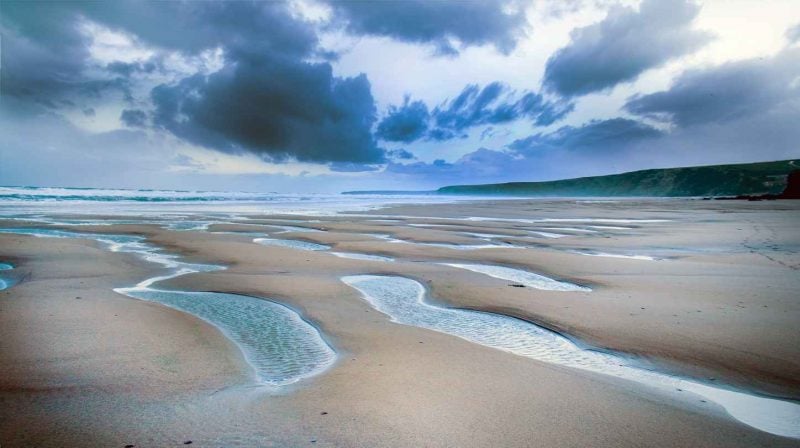
Every summer the Blue Shark appears in the Gulf Stream off the coast of the British Isles. Blue Sharks live in tropical waters around the world.
The gentle Blue Shark people knew until the late 40s only from isolated blue sharks, that were caught before the English channel-coast. They were found in the long nets, which were designed for sardines. The strong fish had got caught in the nets during their attempts to escape and had destroyed many nets.
Shortly after the Second World War, Brigade Commander J.A.L. Caunter began to catch blue sharks from the boat in Looe, Cornwall.
He found that Blue Sharks are quite abundant along the Cornish coast. From that moment on, Blue Shark fishing at Looe developed into a small industry in its own right. However, in recent years the stocks have been declining due to overfishing. So please STOP fishing for Blue Sharks.
We recommend swimming and diving with Blue Sharks. The best place to swim with Blue Sharks in the UK is Cornwall from July until Autumn. Please contact Charles Shark Adventures to book a tour.
Fun Facts About Blue Sharks
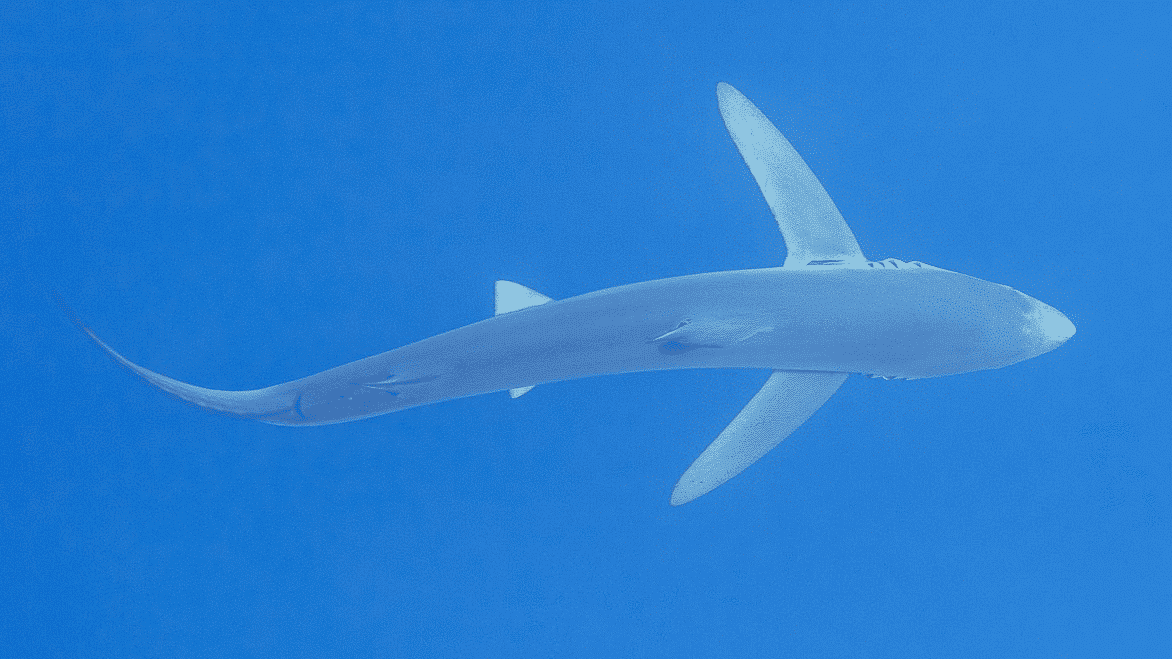
1. The largest caught blue shark
Blue sharks, with slim bodies and long pectoral fins, usually grow to 7-9ft/2.5-3m. The largest blue shark ever caught was 9 ft/3 meter long and weighed 256 LBS. It took four experienced fisherman to get this fantastic creature out of the sea close to the coast of England. The fished blue shark was later released back into the sea where he reportedly was able to swim away.
2. Blue Sharks are Explorers
Blue sharks need space. As they are used to the open water, it is no surprise that they don’t well in captivity. The longest a blue shark was ever kept in captivity was 246 days in an aquarium in Tokyo.
3. Blue Sharks the Reproduction Machines
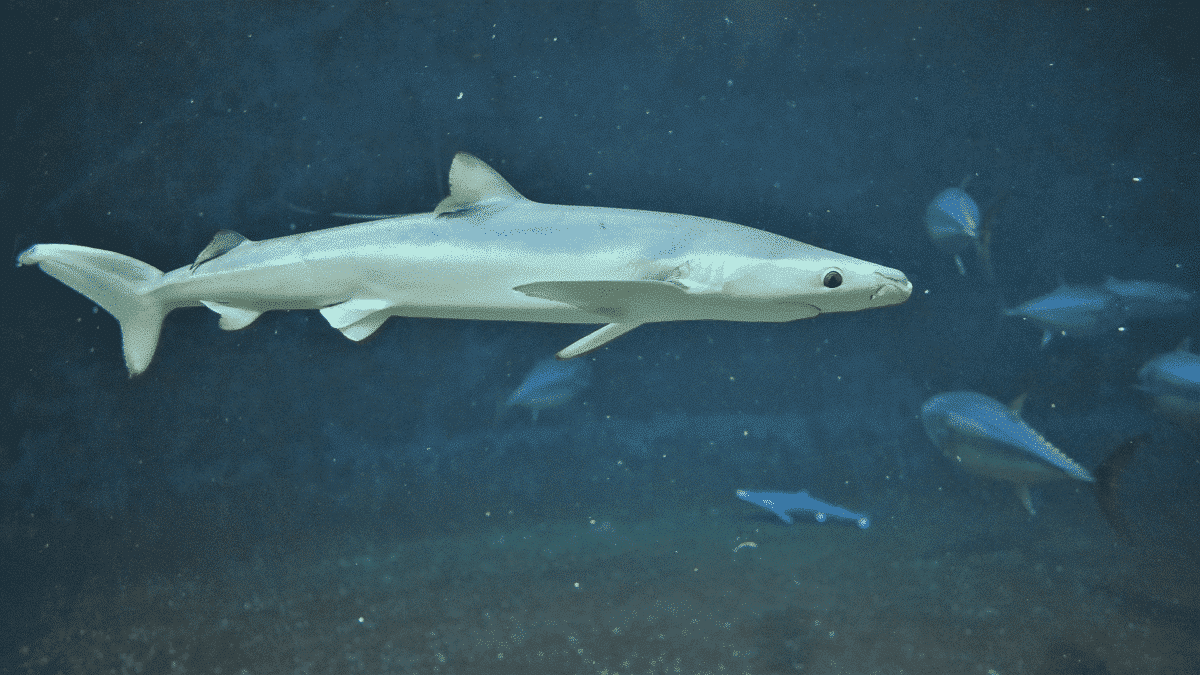
Blue Sharks give birth to between 40 and 63 babies, depending on the age and the size of the mother. The young sharks feed in the mother’s uterus on a yolk in the form of a yolk bag and are about 50 centimeters long at birth. The gestation period is between nine and twelve months.
From a length of about 2.20 meters, the females become sexually mature, which corresponds to an age of four to five years. Nothing is known about the onset of sexual maturity of the males, but they are also believed to be of reproductive age from about four to five years. The oldest until today known animal was approximately 20 years old.
4. A Two Headed Blue Shark
In 2011, scientists found two-headed female blue shark embryos. They were found inside a pregnant adult female that had been caught in the Gulf of California off the western coast of Baja California Sur, Mexico.
A researcher, Felipe Galván-Magaña, speculated, “Abnormal sharks showed a symmetric bicephaly that could be caused by the high number of embryos found in the uterus of the blue shark, which is the most fecund species of shark in the world. The abnormality probably began during the embryonic development.”
Summary of Where to Dive with Blue Sharks
In conclusion, Blue Shark Diving is an incredible adventure. Especially for people who are diving with sharks for the first time in their lives. Explore the beauties of these amazing creatures.
Are you an animal and diving enthusiast?
Check out our posts about Whale Shark Diving. If you are interested in diving with a more dangerous shark, check out our article about Bull Shark Diving. Discover an overview of all of our shark articles here.
[simple-author-box]
- Best Places to See Brown Bears - April 19, 2024
- Animals in Greece - April 19, 2024
- Pangolins: The Complete Guide - April 19, 2024

